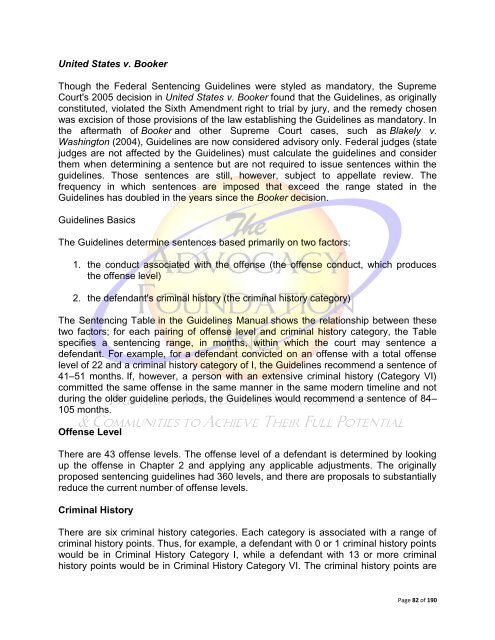The Violent Crime and Law Enforcement Act of 1994
The Violent Crime and Law Enforcement Act of 1994
The Violent Crime and Law Enforcement Act of 1994
You also want an ePaper? Increase the reach of your titles
YUMPU automatically turns print PDFs into web optimized ePapers that Google loves.
United States v. Booker<br />
Though the Federal Sentencing Guidelines were styled as m<strong>and</strong>atory, the Supreme<br />
Court's 2005 decision in United States v. Booker found that the Guidelines, as originally<br />
constituted, violated the Sixth Amendment right to trial by jury, <strong>and</strong> the remedy chosen<br />
was excision <strong>of</strong> those provisions <strong>of</strong> the law establishing the Guidelines as m<strong>and</strong>atory. In<br />
the aftermath <strong>of</strong> Booker <strong>and</strong> other Supreme Court cases, such as Blakely v.<br />
Washington (2004), Guidelines are now considered advisory only. Federal judges (state<br />
judges are not affected by the Guidelines) must calculate the guidelines <strong>and</strong> consider<br />
them when determining a sentence but are not required to issue sentences within the<br />
guidelines. Those sentences are still, however, subject to appellate review. <strong>The</strong><br />
frequency in which sentences are imposed that exceed the range stated in the<br />
Guidelines has doubled in the years since the Booker decision.<br />
Guidelines Basics<br />
<strong>The</strong> Guidelines determine sentences based primarily on two factors:<br />
1. the conduct associated with the <strong>of</strong>fense (the <strong>of</strong>fense conduct, which produces<br />
the <strong>of</strong>fense level)<br />
2. the defendant's criminal history (the criminal history category)<br />
<strong>The</strong> Sentencing Table in the Guidelines Manual shows the relationship between these<br />
two factors; for each pairing <strong>of</strong> <strong>of</strong>fense level <strong>and</strong> criminal history category, the Table<br />
specifies a sentencing range, in months, within which the court may sentence a<br />
defendant. For example, for a defendant convicted on an <strong>of</strong>fense with a total <strong>of</strong>fense<br />
level <strong>of</strong> 22 <strong>and</strong> a criminal history category <strong>of</strong> I, the Guidelines recommend a sentence <strong>of</strong><br />
41–51 months. If, however, a person with an extensive criminal history (Category VI)<br />
committed the same <strong>of</strong>fense in the same manner in the same modern timeline <strong>and</strong> not<br />
during the older guideline periods, the Guidelines would recommend a sentence <strong>of</strong> 84–<br />
105 months.<br />
Offense Level<br />
<strong>The</strong>re are 43 <strong>of</strong>fense levels. <strong>The</strong> <strong>of</strong>fense level <strong>of</strong> a defendant is determined by looking<br />
up the <strong>of</strong>fense in Chapter 2 <strong>and</strong> applying any applicable adjustments. <strong>The</strong> originally<br />
proposed sentencing guidelines had 360 levels, <strong>and</strong> there are proposals to substantially<br />
reduce the current number <strong>of</strong> <strong>of</strong>fense levels.<br />
Criminal History<br />
<strong>The</strong>re are six criminal history categories. Each category is associated with a range <strong>of</strong><br />
criminal history points. Thus, for example, a defendant with 0 or 1 criminal history points<br />
would be in Criminal History Category I, while a defendant with 13 or more criminal<br />
history points would be in Criminal History Category VI. <strong>The</strong> criminal history points are<br />
Page 82 <strong>of</strong> 190
















